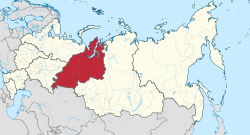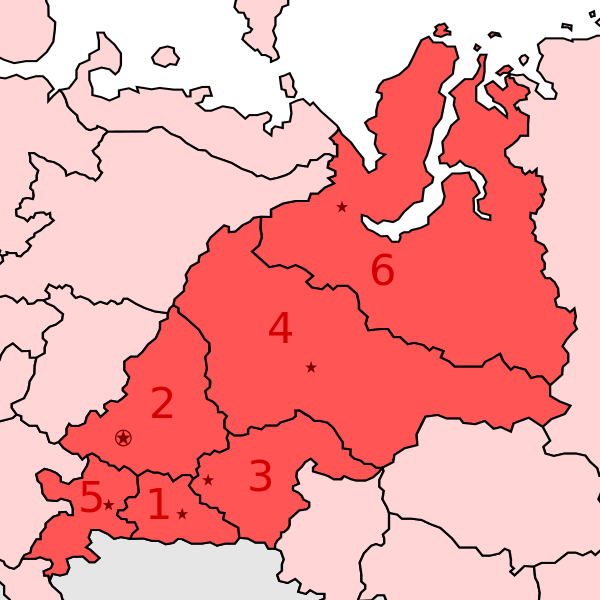منطقة الأورال الاتحادية
56°50′N 60°35′E / 56.833°N 60.583°E
منطقة الأورال الاتحادية
Уральский федеральный округ | |
|---|---|
 موقع منطقة الأورال الاتحادية في روسيا. | |
| البلد | |
| تأسست | 18 مايو 2000 |
| المركز الاداري | يكاترينبورگ |
| الحكومة | |
| • المبعوث الرئاسي | Vladimir Yakushev |
| المساحة | |
| • إجمالي | 1٬818٬500 كم² (702٬100 ميل²) |
| ترتيب المساحة | 3 |
| التعداد (2010) | |
| • إجمالي | 12٬080٬526[1] |
| • الترتيب | 6 |
| • Urban | 79٫9%[1] |
| • الريف | 20٫1%[1] |
| GDP | |
| • Total | ₽ 20.073 trillion US$ 287 billion (2022) |
| • Per capita | ₽ 1,635,678 US$ 23,402 (2022) |
| الكيانات الاتحادية | 6 |
| المناطق الاقتصادية | 2 |
| HDI (2021) | 0.839[3] very high · 2nd |
| الموقع الإلكتروني | www |
منطقة الأورال الاتحادية (روسية: Ура́льский федера́льный о́круг, Uralsky federalny okrug، Ural Federal District)، هي إحدى المناطق الاتحادية التسعة الروسية. عدد سكانها 12.080.523 نسمة (79.9% حضر) حسب تعداد 2010.[1]
تأسست المنطقة بمرسوم رئاسي في 18 مايو 2000.[4] معظم المنطقة يقع في منطقة الأورال الجغرافية، لكن هناك أجزاء صغيرة منها تقع في منطقة الڤولگا. تقع المنطقة على حدود روسيا الأوروپية-الآسيوية،[5] ويختلف امتدادها عن منطقة الأورال الاقتصادية. المركز الاداري للمنطقة مدينة يكاترينبورگ.
تسهم المنطقة بنسبة 18% من الناتج المحلي الإجمالي الروسي، بالرغم من أن عدد سكانها يشكل 8.5% فقط من إجمالي سكان روسيا.[6]
معلومات عامة وإحصائيات
Ethnic composition, according to the 2010 census:
The district covers an area of 1,818,500 square kilometers (702,100 sq mi),[7] about 10% of Russia. According to the 2010 Census, the district had a population of 12,080,526,[1] of whom 82.74% were Russians (10,237,992 people), 5.14% Tatars (636,454), 2.87% Ukrainians (355,087) and 2.15% Bashkirs (265,586). The remainder comprises various ethnicities of the former Soviet Union. 79.9% of the district's population lived in urban areas.[1]
In 2006, the district provided 90% of Russian natural gas production, 68% of oil and 42% of metal products. Industrial production per capita in the district is about 2.5 times higher than the average value throughout Russia. The district provides about 42% of Russian tax incomes, mostly from industry. Its major branches are fuel mining and production (53%), metallurgy (24%) and metal processing and engineering (8.8%). The latter two are especially developed in Chelyabinsk and Sverdlovsk Oblast which, between them, constitute 83% of Russian metallurgy and 73% of metal processing and engineering. Whereas fuel and mineral mining has been providing a nearly constant outcome between 1990 and 2006, metal processing and engineering are declining, despite the fact that they employ up to 30% of industry workers of the district. Local ore processing plants can provide only 20% of required copper, 28% chromium, 35% iron and 17% coal, and many of these resources are nearly exhausted. Meanwhile, the average distance to import them to the Ural is 2,500 km.[8]
The district is governed by the Presidential Envoy, and individual envoys are assigned by the President of Russia to all the Oblasts of the district. Pyotr Latyshev was envoy to the Urals Federal District until his death on 2 December 2008. Nikolay Vinnichenko succeeded him on this post on 8 December 2008.[9] On 6 September 2011 Vinnichenko was appointed the envoy to the Northwestern Federal District, and Yevgeny Kuyvashev became the Presidential Envoy in the Ural Federal District.[10] On 18 May 2012 Vladimir Putin offered the tenure to Igor Kholmanskikh, an engineer without any previous political experience, and Kholmanskikh accepted the offer.[11] On 26 June 2018, Kholmanskikh was replaced by Nikolay Tsukanov.[12]
Federal subjects
The district comprises the Central (part) and West Siberian economic regions and six federal subjects:

| ||||||||
|---|---|---|---|---|---|---|---|---|
| # | العلم | الدرع | الكيان الاتحادي | المركز الإداري |
المساحة (كم²) | التعداد | ن.م.إ.[13] | خريطة |
| 1 | 
|
اوبلاست كورگان | كورگان | 71,000 | 776,661 | ₽268 billion | ||
| 2 | اوبلاست سڤردلوڤسك | يكاترينبورگ | 194,226 | 4,268,998 | ₽3,038 billion | 
| ||
| 3 | اوبلاست تيومن | تيومن | 143,520 | 1,601,940 | ₽1,536 billion | |||
| 4 | اُكروگ خانتي-مانسيسك المستقل ذاتياً (يوگرا) | خاتني-مانسيسك | 534,800 | 1,711,480 | ₽5,652 billion | 
| ||
| 5 | 
|
اوبلاست چلیابنسك | چلیابنسك | 87,900 | 3,431,224 | ₽2,043 billion | 
| |
| 6 | 
|
اُكروگ يمالو-ننتس المستقل ذاتياً | سالخارد | 750,300 | 510,490 | ₽4,162 billion | 
| |
مصدر أسماء مناطق الأورال الستة: [14] (ملاحظة - يشير المصدر إلى "المناطق" بدلاً من الاوكروگات أو الاوبلاستات)
Religion
According to a 2012 survey[15] 32.7% of the population of the Ural Federal District adheres to the Russian Orthodox Church, 6.9% are unaffiliated generic Christians, 3.4% is an Eastern Orthodox believer without belonging to any church or adheres to other (non-Russian) Eastern Orthodox churches, 6.0% is an adherent of Islam, and 1.1% adhere to some native faith such as Rodnovery. In addition, 31.2% of the population declares to be "spiritual but not religious", 12.8% is atheist, and 5.9% follows other religions or did not give an answer to the question.[15]
Presidential plenipotentiary envoys to the Ural Federal District
| № | Name (envoy) | Photo | Term of office | Appointed by | ||
|---|---|---|---|---|---|---|
| Start of term | End of term | Length of service | ||||
| 1 | Pyotr Latyshev[17] | 
|
18 May 2000 | 2 December 2008 | 8 years, 198 days (3٬120 days) | Vladimir Putin |
| - | Vladimir Krupkin (acting) |
2 December 2008 | 8 December 2008 | 6 days | Dmitry Medvedev | |
| 2 | Nikolay Vinnichenko[18][19] | 
|
8 December 2008 | 6 September 2011 | 2 years, 272 days (1٬002 days) | |
| 3 | Yevgeny Kuyvashev[20][21] | 
|
6 September 2011 | 14 May 2012 | 251 days | |
| 4 | Igor Kholmanskikh[22][23] | 
|
18 May 2012 | 26 June 2018 | 6 years, 39 days (2٬230 days) | Vladimir Putin |
| 5 | Nikolay Tsukanov[24] | 
|
26 June 2018 | 9 November 2020 | 2 years, 136 days (867 days) | |
| 6 | Vladimir Yakushev | 
|
9 November 2020 | present | 4 years, 138 days (1٬599 days) | |
المصادر
- ^ أ ب ت ث ج ح Russian Federal State Statistics Service (2011). "Всероссийская перепись населения 2010 года. Том 1". Всероссийская перепись населения 2010 года (2010 All-Russia Population Census) (in Russian). Federal State Statistics Service. Retrieved June 29, 2012.
{{cite web}}: Invalid|ref=harv(help); Unknown parameter|trans_title=ignored (|trans-title=suggested) (help)CS1 maint: unrecognized language (link) - ^ Валовой региональный продукт по субъектам Российской Федерации в 2016-2022 гг., rosstat.gov.ru, https://rosstat.gov.ru/storage/mediabank/VRP_s_1998.xlsx
- ^ "Sub-national HDI - Area Database - Global Data Lab". hdi.globaldatalab.org (in الإنجليزية). Retrieved 2021-07-20.
- ^ "Указ Президента РФ от 13 мая 2000 г. N 849 "О полномочном представителе Президента Российской Федерации в федеральном округе" (Decree #849 by the President of Russia of May 13, 2000)" (in Russian).
{{cite web}}: CS1 maint: unrecognized language (link) - ^ http://www.smsr-senclub.ru/en/region/index.php?SECTION_ID=350
- ^ "5 Ural Federal District: The Backbone of the Nation's Economy". Russia’s Regions: Goals, Challenges, Achievements (PDF). National Human Development Report. UNDP. 2006/07. p. 68. Retrieved 3 December 2013.
{{cite book}}: Check date values in:|date=(help) - ^ خطأ استشهاد: وسم
<ref>غير صحيح؛ لا نص تم توفيره للمراجع المسماةarea - ^ Екатеринбург, 02 Декабря 2006 (in الروسية). Official site of the Ural Federal District. Archived from the original on أغسطس 12, 2007.
- ^ "Vinnichenko for Urals Federal District" (in الروسية). interfax.ru.
- ^ О назначении полпредов Президента в ряде федеральных округов (in الروسية). Администрация Президента РФ. September 6, 2011. Retrieved 20 May 2012.
- ^ "Предложение президента для Игоря Холманских стало неожиданностью". Vesti.ru. Russian. May 18, 2012. Retrieved May 20, 2012.
- ^ "Игорь Холманских уволен с поста полпреда президента в Уральском федеральном округе" (in الروسية). Meduza. 26 June 2018. Retrieved 27 June 2018.
- ^ "Валовой региональный продукт". rosstat.gov.ru.
- ^ "Ural region". Corporation of Development. Retrieved 26 January 2014.
- ^ أ ب ت "Arena: Atlas of Religions and Nationalities in Russia". Sreda, 2012.
- ^ 2012 Arena Atlas Religion Maps. "Ogonek", № 34 (5243), August 27, 2012. Retrieved April 21, 2017. Archived.
- ^ "Указ Президента Российской Федерации от 18.05.2000 г. № 893" (in الروسية). Kremlin.ru. 18 May 2000. Retrieved 16 November 2019.
- ^ "Указ Президента Российской Федерации от 08.12.2008 г. № 1749" (in الروسية). Kremlin.ru. 8 December 2008. Retrieved 16 November 2019.
- ^ "Указ Президента Российской Федерации от 06.09.2011 г. № 1162" (in الروسية). Kremlin.ru. 6 September 2011. Retrieved 16 November 2019.
- ^ "Указ Президента Российской Федерации от 06.09.2011 г. № 1164" (in الروسية). Kremlin.ru. 6 September 2011. Retrieved 16 November 2019.
- ^ "Указ Президента Российской Федерации от 14.05.2012 г. № 619" (in الروسية). Kremlin.ru. 14 May 2012. Retrieved 16 November 2019.
- ^ "Указ Президента Российской Федерации от 18.05.2012 г. № 626" (in الروسية). Kremlin.ru. 18 May 2012. Retrieved 16 November 2019.
- ^ "Указ Президента Российской Федерации от 26.06.2018 г. № 366" (in الروسية). Kremlin.ru. 26 June 2018. Retrieved 16 November 2019.
- ^ "Указ Президента Российской Федерации от 26.06.2018 г. № 371" (in الروسية). Kremlin.ru. 26 June 2018. Retrieved 16 November 2019.
- Pages using gadget WikiMiniAtlas
- CS1 errors: unsupported parameter
- CS1 uses الروسية-language script (ru)
- CS1 الروسية-language sources (ru)
- Short description is different from Wikidata
- Articles with hatnote templates targeting a nonexistent page
- Coordinates on Wikidata
- Pages using infobox settlement with no coordinates
- Articles containing روسية-language text
- Pages using Lang-xx templates
- منطقة الأورال الاتحادية
- المناطق الاتحادية الروسية
- دول ومناطق تأسست في 2000
- تأسيسات 2000 في روسيا
- صفحات مع الخرائط


